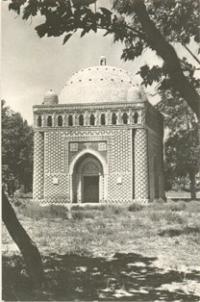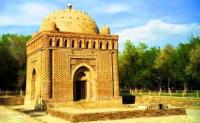You are here
Ismail Samani mausoleum.


Excursion tours on Bukhara.
“Amir Ismail Samani took away all the estates and arable land from Abu-Ishaq. The reason for the selection was the fact that Ahmad, the son of Muhammad, the grandson of Lyays, who was at that time the military commander, once asked Ismail Samani: "Amir! “These estates do not belong to them, but constitute the property of the government, answered Amir Ismail Samani”
Muhammad Narshahi. "History of Bukhara".
Tours to Ismail Samani mausoleum in Bukhara.
The world famous is the mausoleum of Ismail Samani, which is located opposite the Arch, in the depths of the Central Park of Culture and Recreation. This very, unique structure attracts the attention of scientists around the world.
An outstanding monument is studied by architects and historians; artists write pictures from it. All those who are interested in the historical past of the peoples of Central Asia invariably turn to him. The monument testifies to the great development of construction equipment and a high level of architectural art.
It was during this period that high-quality burnt brick and alabaster solution were used in construction. The construction of the mausoleum of Ismail Samani was preceded by the development of mathematical knowledge, especially geometry, which armed the most experienced and knowledgeable building masters with the methods of preliminary design of buildings, calculating its proportions based on mathematical relationships.
That is what caused the charming harmony of the whole and its parts, which we observe in the mausoleum of Ismail Samani in Bukhara. The mausoleum is a type of central structure, the bulk of which is formed by a cube with planes slightly obliquely upward and a hemispherical dome.
The peculiarity of the mausoleum is the structure that connects the dome with the squares of the walls. This design has determined to a large extent the interior and exterior of the building. The building of the mausoleum should be strong, although it performed the task of the most lightweight construction.
On massive, 1.8 m thick, walls of a square room were installed relatively thin arches - four arches on the walls and four corners. Thick walls protected the monument from destruction for a whole millennium. Behind the arches on the top of the building is a bright gallery opening from the outside with an arcade of small lancet windows.
This gives lightness and elasticity to the structure and creates a kind of lighting inside the mausoleum. All four facades of the mausoleum of Ismail Samani are unique. The middle of each side is cut by a large pointed arch, the corners are flanked by powerful three-quarter brick columns.
The walls of the building inside and outside are decorated with a patterned brickwork that creates a rich light and shade texture of the walls, giving a certain lightness to the building. Samanid Mausoleum, built at the turn of the IXth - Xth centuries, according to legend, was built by Ismail Samani - the actual founder of the Samanid state that seized Bukhara in 874 and made it its capital - for his father Amed ibn Asad. Later, the mausoleum of the Samani family tomb: Ismail himself was buried there, and then, according to the inscriptions above the entrance, Ismail's grandson.
The time of construction of the mausoleum of Ismail Samani lies between 892 and 943 years. The building is well preserved to our time and is in excellent condition. The mausoleum can rightfully be considered one of the most advanced works of world architecture.
The purpose of the mausoleum as a tomb led to the creation of a single-chamber square room with a three-stage interior structure: a quadrangle, octagon, and a cup of the dome. It must be assumed that by the time of construction of the mausoleum, such an interpretation of the interior of the kupole building passed a long way of development and became traditional.
Of particular interest to us is the design of the light openings of the Samanids Mausoleum gallery: a relatively high (to the floor level) arrangement of the light openings, their tiny dimensions resembling loopholes, the presence of inclined window windows, lined niches outside the building .
Approaching the Ark by road a pair of XVI century kosh madrasas, facing each other nonchalantly across street, near the east end of Samani town park. On the left facing east, the Abdullah Khan madrasa (1588 - 1590) was architecturally daring for its time because the cells radiating off its north and west iwarts cause the overall shape to depart from the standard madrasa rectangle.
The Modari Khan madrasa opposite was dedicated by Abdullah Khan to his mother in 1567 (974 in the Islamic calendar), according to a verse in majolica over the main entrance. In any other city these buildings would be the object of huge curatorial fuss.
In Bukhara two other kosh ensembles outshine them. They are padlocked, unrestored and hardly visited. When Samani mausoleum was laid out in the 1930, a Russian archaeologist called Shishkin rediscovered an architectural gem that had languished under two metres of sediment for the 400 years of the khanate.
The Ismoil Samani mausoleum is one of the world's oldest monuments to famous Muslims. Samani built it for his father and grandson in 907, and was later buried here himself. It is unique in bearing traces of pre-Islamic, Sogdian culture while pioneering architectural and decorative techniques that were to be used for the next five centuries.
Its cubic base, representing the earth, supports a heavenly hemisphere to form a Sogdian metaphor for the universe. Built before ceramics came to Central Asia, the mausoleum consists entirely of clay bricks bound with egg yolk and camels' milk-but no ordinary bricklayer was at work here.
In Geoffrey Moorhouse's words, 'someone obsessed with the possibilities inherent in brick had been trying to push variety to its limits. The bricks are arranged in 18 different two- and three dimensional-patterns which make the massive walls look featherweight, creating in some places 'the texture of elaborate basketwork', in others a lattice through which an evening breeze might cool the summer heat inside'.
The lower part of the mausoleum has survived in all its intricacy for a thousand years. Shishkin restored the dome and corner cupolas in the 1930 with egg-and-milk bricks which are virtually indistinguishable from the originals.
He also cleared away the sediment to reveal the building's full height, and moved to another cemetery the graves which had crowded around when this was a fashionable place to be buried. Now you can walk right round the mausoleum. If you do three circuits and make a wish, the wish will come true.
Enlightener:
V.G Saakov «History of Bukhara». Publishing house "Shark", 1996. «Bukhara. Masterpieces of the Central Asia». The historical guidebook across Bukhara. 2012. "Bukhoro. Bukhara" In the Uzbek, English and Russian languages. Publishing house "Uzbekistan", Tashkent 2000. Mukhammad Narkshakhi. History of Bukhara. Tashkent. 1897 (translator N.Lykoshina). V.G.Saakov "Architectural masterpieces of Bukhara. A Bukhara regional society "Kitabhon" Uzbek SSR, Exactly 1991 Robert Almeev. "History of ancient Bukhara". (Under edition of the Academician of the Academy of sciences of Republic Uzbekistan of Rtveladze E.V.)
Photos
Alexander Petrov.







